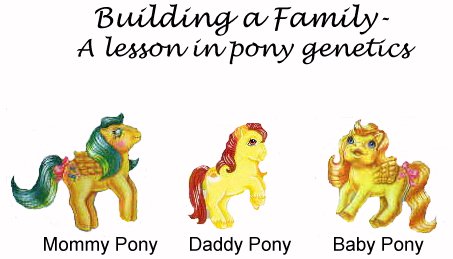
There are many different types and breeds of ponies each possessing their own unique characteristics. When designing a pony family these characteristics must be taken into account in for a realistic outcome. Use the following charts to help you decide what kind of ponies you want for your family. To learn more about designing individual ponies, go to our Ponyology Page.

The type of pony is a consideration as well. Two unicorns will always have a unicorn baby. However, if the parents are of different types, the baby will be one type or the other, usually the dominant type. Very rarely, when one parent is a unicorn and the other a pegasus, they will have unipeg baby.

When making a family, try to use ponies that have at least one thing in common. Our example ponies all have a yellow body. Your common characteristic may be body color, hair color, or breed, however, they must share at least one.
- Body Color
- The simple laws of genetics tell us that if the parents are yellow, the baby must also be yellow. However, if one parent is yellow, and the other is white, than the baby may be either color or a mix of the two. The exact shade of color is irrelevant, as that should differ from pony to pony anyway. A group of ponies with the same body color will very often set them apart as a family from a display, making this an excellent choice as a common characteristic.
- Hair Color
- Another possible common ground is hair color. The same rules set for body color also apply here. However, if the one of the parents has a streaked mane, the baby may pick up the streak color as it's entire hair color. This streak is called a recessive gene. This also applies to hair type.
- Symbol Design
- Most families have a symbol that is somehow related. For instance, if the mother is Moondancer and the father's symbol is the sun, then the baby's symbol will be related to the cosmos. Also, symbol type is another consideration. Two Twice As Fancy Ponies will always have a Twice As Fancy baby. If the parent's symbol are not of the same type, the baby may be either or a mix of the two.
- Eye Color
- A family does not have to have the same eye color, although it is preferred. If the parents have different colors than the baby will be one of the two, or a mix of both. A mix could mean one eye red and one blue, or both eyes purple. Twinkle-eyes is a recessive gene, and is rarely passed down, however if it is, both eyes must be twinkle-eyes.

Back




